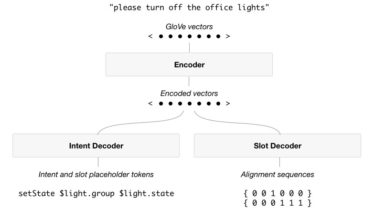Intent parsing and slot filling in PyTorch with seq2seq + attention

PyTorch Seq2Seq Intent Parsing
Reframing intent parsing as a human – machine translation task. Work in progress successor to torch-seq2seq-intent-parsing
The command language
This is a simple command language developed for the “home assistant” Maia living in my apartment. She’s designed as a collection of microservices with services for lights (Hue), switches (WeMo), and info such as weather and market prices.
A command consists of a “service”, a “method”, and some number of arguments.
lights setState office_light on
switches getState teapot
weather getWeather "San Francisco"
price getPrice TSLA
These can be represented with variable placeholders:
lights setState $device $state
switches getState $device
weather getWeather $location
price getPrice $symbol
We can imagine a bunch of human sentences that would map to a single